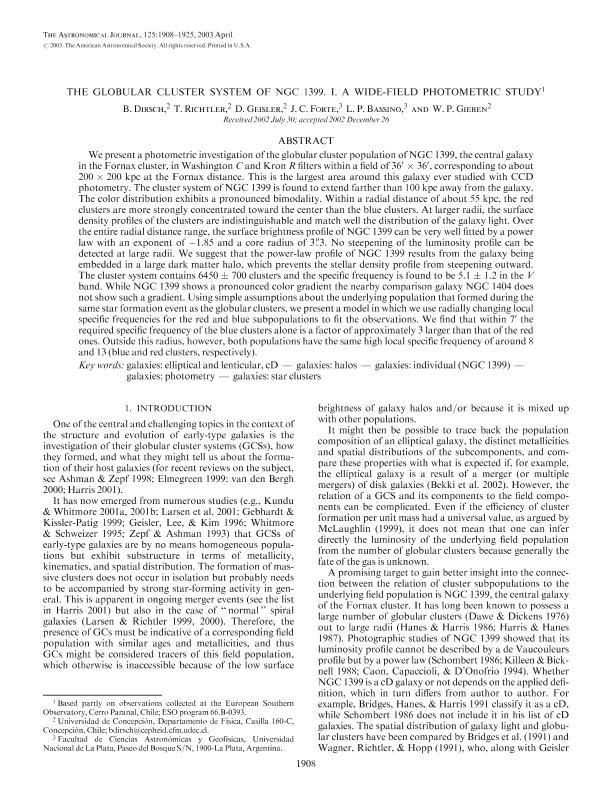Mostrar el registro sencillo del ítem
dc.contributor.author
Dirsch, B.
dc.contributor.author
Richtler, T.
dc.contributor.author
Geisler, D.
dc.contributor.author
Forte, Juan Carlos

dc.contributor.author
Bassino, Lilia Patricia

dc.contributor.author
Gieren, W. P.
dc.date.available
2018-02-20T17:28:06Z
dc.date.issued
2003-12
dc.identifier.citation
Dirsch, B.; Richtler, T.; Geisler, D.; Forte, Juan Carlos; Bassino, Lilia Patricia; et al.; The Globular Cluster System of NGC 1399, I : a wide-field photometric study; IOP Publishing; Astronomical Journal; 125; 12-2003; 1908-1925
dc.identifier.issn
0004-6256
dc.identifier.uri
http://hdl.handle.net/11336/36811
dc.description.abstract
We investigate the sample of 1175 new nonmagnetic DA white dwarfs with the effective temperatures Teff ≥ 12 000 K, which were extracted from the Data Release 1 of the Sloan Digital Sky Survey. We determined masses, radii, and bolometric luminosities of stars in the sample. The above parameters were derived from the effective temperatures Teff and We present a photometric investigation of the globular cluster population of NGC 1399, the central galaxy in the Fornax cluster, in Washington C and Kron R filters within a field of 360 360 , corresponding to about 200 200 kpc at the Fornax distance. This is the largest area around this galaxy ever studied with CCD photometry. The cluster system of NGC 1399 is found to extend farther than 100 kpc away from the galaxy. The color distribution exhibits a pronounced bimodality. Within a radial distance of about 55 kpc, the red clusters are more strongly concentrated toward the center than the blue clusters. At larger radii, the surface density profiles of the clusters are indistinguishable and match well the distribution of the galaxy light. Over the entire radial distance range, the surface brightness profile of NGC 1399 can be very well fitted by a power law with an exponent of 1.85 and a core radius of 3>3. No steepening of the luminosity profile can be detected at large radii. We suggest that the power-law profile of NGC 1399 results from the galaxy being embedded in a large dark matter halo, which prevents the stellar density profile from steepening outward. The cluster system contains 6450 700 clusters and the specific frequency is found to be 5.1 1.2 in the V band. While NGC 1399 shows a pronounced color gradient the nearby comparison galaxy NGC 1404 does not show such a gradient. Using simple assumptions about the underlying population that formed during the same star formation event as the globular clusters, we present a model in which we use radially changing local specific frequencies for the red and blue subpopulations to fit the observations. We find that within 70 the required specific frequency of the blue clusters alone is a factor of approximately 3 larger than that of the red ones. Outside this radius, however, both populations have the same high local specific frequency of around 8 and 13 (blue and red clusters, respectively)
dc.format
application/pdf
dc.language.iso
eng
dc.publisher
IOP Publishing

dc.rights
info:eu-repo/semantics/openAccess
dc.rights.uri
https://creativecommons.org/licenses/by-nc-sa/2.5/ar/
dc.subject
Elliptical Galaxies
dc.subject
Lenticular Galaxies
dc.subject
Halos
dc.subject
Ngc 1399 (Galaxia)
dc.subject
Photometry
dc.subject
Star Clusters
dc.subject.classification
Astronomía

dc.subject.classification
Ciencias Físicas

dc.subject.classification
CIENCIAS NATURALES Y EXACTAS

dc.title
The Globular Cluster System of NGC 1399, I : a wide-field photometric study
dc.type
info:eu-repo/semantics/article
dc.type
info:ar-repo/semantics/artículo
dc.type
info:eu-repo/semantics/publishedVersion
dc.date.updated
2018-02-19T16:54:14Z
dc.journal.volume
125
dc.journal.pagination
1908-1925
dc.journal.pais
Estados Unidos

dc.journal.ciudad
Washington, USA
dc.description.fil
Fil: Dirsch, B.. Universidad de Concepción; Chile
dc.description.fil
Fil: Richtler, T.. Universidad de Concepción; Chile
dc.description.fil
Fil: Geisler, D.. Universidad de Concepción; Chile
dc.description.fil
Fil: Forte, Juan Carlos. Universidad Nacional de la Plata. Facultad de Ciencias Astronómicas y Geofísicas; Argentina
dc.description.fil
Fil: Bassino, Lilia Patricia. Universidad Nacional de la Plata. Facultad de Ciencias Astronómicas y Geofísicas; Argentina
dc.description.fil
Fil: Gieren, W. P.. Universidad de Concepción; Chile
dc.journal.title
Astronomical Journal

dc.relation.alternativeid
info:eu-repo/semantics/altIdentifier/doi/http://dx.doi.org/10.1086/368238
dc.relation.alternativeid
info:eu-repo/semantics/altIdentifier/url/http://iopscience.iop.org/article/10.1086/368238/meta
Archivos asociados
